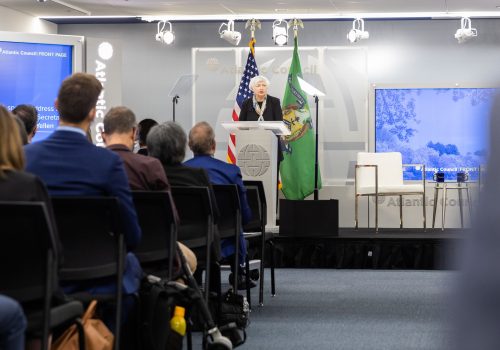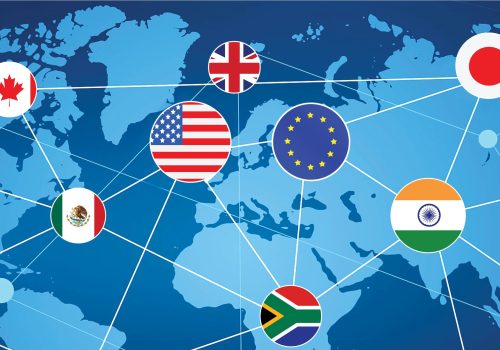Is ‘friendshoring’ really working?
Friendship takes time. So, too, does friendshoring. Speaking at the Atlantic Council a little over one year ago, US Secretary of the Treasury Janet Yellen announced a new approach to organizing the global supply chains that provide US consumers and companies with critical goods. Defining it as “friendshoring,” Yellen described an international economic policy intended to “achieve free but secure trade” by “favoring the friendshoring of supply chains to a large number of trusted countries.”
Implicit throughout Yellen’s speech was the need to move supply chains from China to US partners such as Taiwan, India, Vietnam, and Mexico. But supply chains don’t change overnight, and anyone expecting friendshoring to result in a quick and decisive uncoupling of the US economy from China will find little in this past year’s data pointing toward that result. Progress on reducing China’s share of US goods imports has been modest and, in some cases, China’s share of US imports has actually increased. A closer look at the data, however, reveals the consequences of Yellen’s approach are beginning to play out, even as challenges—in particular regarding green energy and critical minerals—remain for the administration’s ambitious initiative.
While Yellen was not specific in her speech at the Atlantic Council about which goods the United States intends to friendshore, other parts of the Biden administration have provided more details. Released in February 2021, Executive Order 14017, “Executive Order on America’s Supply Chains,” states four broad product categories US friendshoring efforts should target: (1) public health and biological preparedness, (2) information and communications technology (ICT), (3) energy, and (4) critical minerals and materials. Based on that executive order, the US Department of Commerce’s International Trade Administration (ITA) constructed a list of around 2,400 critical goods and materials within those four supply chains. By cross-referencing the products identified by the ITA with US Census Bureau trade data, we have built a detailed data set on the status of US friendshoring efforts.
The 2,400 products the ITA has identified as falling under US friendshoring efforts amount to around $1.6 trillion worth of annual US goods imports. In 2020, Chinese suppliers contributed some 16.2 percent of US imports of goods Washington now aims to friendshore (already down considerably from China’s 2017 pre-trade-war average of 19.2 percent). In the year following Yellen’s friendshoring speech, this share has fallen even lower, to 15.2 percent. However, within the four product categories that broadly organize US friendshoring interests, China’s prevalence in US supply chains drastically varies.
Information and communications technology imports
Continued Chinese dominance of US critical supply chains is most prominent in the ICT sector. This category of goods covers products such as computers, telecommunications infrastructure, and semiconductors, as well as component parts of those items. At their peak, Chinese companies supplied more than 45 percent of US imports of key ICT goods. This import share was considerably higher for certain kinds of ICT goods, namely computer equipment, of which China supplied nearly 63 percent of US imports in late 2017. However, the trade war initiated by the Trump administration reduced this reliance. The high import tariffs imposed on most Chinese technology imports increased the competitiveness of new exporters such as Vietnam and Malaysia. This forced Chinese companies to lose market share or, in some cases, move their own production out of China and into nations with friendly ties to Washington such as Mexico.
Despite these efforts, Chinese producers still dominate US imports of a number of ICT products that the Biden administration has identified as friendshoring priorities. Two prominent examples include personal computers, of which China still supplies 83 percent of US overall imports, worth around $2.7 billion each month, and smartphones, of which China supplies 66 percent of US imports, worth nearly $2.6 billion each month. More broadly, Chinese companies still supply more than half of US imports for 62 percent of the ICT goods the United States aims to friendshore.
Public health and biological preparedness
Goods that fall under the public health and biological preparedness category have the second highest concentration of Chinese imports. This category includes pharmaceutical drugs, active pharmaceutical ingredients (APIs), personal protective equipment (PPE), and clinical tests. However, unlike China’s broad dominance of ICT supply chains, US overreliance on Chinese public health products is largely isolated to PPE, with 31 percent of US imports of PPE originating from China. Within PPE, reliance on China for certain goods is even more pronounced. Chinese companies supply a majority of US imports of a range of PPE, including plastic medical gloves (91 percent), surgical textiles (83 percent), medical aprons (81 percent), and disinfectant wipes (78 percent). This is especially concerning given that Washington’s efforts to reshore this production to domestic manufacturers following the COVID-19 pandemic have largely failed.
Overall, Chinese companies supply a majority of US imports for 46 percent of products that fall under critical PPE. When looking more generally at US imports of critical public health goods (including PPE), the share of products for which China is the majority supplier falls to 31 percent.
Green energy products and critical minerals
Of the four product categories identified by the Biden administration as important to friendshoring efforts, energy products and critical minerals are where the United States currently has the least reliance on China. However, demand for the goods within both product categories is rapidly increasing. Given that China is often the only supplier that can scale production at the magnitudes needed to meet US demand, absent deliberate government interventions, the United States could quickly become dangerously reliant on Chinese imports.
US imports of Chinese large-capacity batteries are a harbinger of this growing overreliance. Aggregate US imports of Chinese critical energy products are potentially manageable, with Chinese suppliers making up just over 6 percent of the US import share. However, when looking at large-capacity batteries—such as those used in electric vehicles and stationary electricity storage—Chinese market share jumps to 35 percent. This trend shows little sign of reversing, at least in the short term, since China has gained an additional 4.8 percent of the US large-capacity battery market since Yellen’s speech. The United States is also becoming increasingly reliant on China for imports of neodymium magnets—a critical component for wind turbines—and nuclear power.
As in the case of energy products, Washington’s reliance on critical minerals from Beijing is low, with just around 4 percent of friendshored critical minerals products originating from China. But this is rapidly changing. Many of the minerals identified by the Biden administration as important to friendshore are integral for the manufacturing needed to support the green energy transition. As with energy products, China often emerges as the only producer with the scalability to match growing demand.
Battery manufacturing provides a strong example of the supply relationships the United States is hoping to avoid. As the United States has rapidly scaled up its manufacturing capacity, it has become deeply reliant on China for a range of materials used in battery production, including nickel oxides and hydroxides (China provides 87 percent of imports), unwrought manganese (83 percent of imports), and different forms of natural graphite, for which US reliance on Chinese imports ranges from 54 to 79 percent. This dependence undercuts any successful friendshoring of finished goods because reliance on China persists for the materials required to produce those final goods.
Future friendshoring
A faster supply chain de-risking was in progress under the previous administration, before Yellen articulated it as a strategy or the Biden administration began issuing executive orders. The driver of this trend was the US-China trade war begun in 2018 and the import tariffs associated with it. It was a blunt tool to remake US supply chains; costly, yet effective in reducing China’s market share, particularly in the information technology space. At the same time, China still supplies more than half of US imports for 279 of the 2,400 products identified by the ITA to be friendshored.
Instead of additional broad-based tariffs on China, the Biden administration has taken a targeted approach. It has pursued a range of bilateral and multilateral arrangements, including its Minerals Security Partnership built around critical mineral supply chains and the “Chip 4 alliance” with Taiwan, Japan, and South Korea focusing on semiconductors. Such an approach will become increasingly important in order to ensure Chinese actions around one or two products, such as their recent moves to curtail the export of gallium and germanium, do not disrupt entire, deeply connected supply networks. The targeted approach is by design slower, but if enough of these interventions build over time, as the Biden administration hopes they do, then it could nonetheless shift US trade in significant ways in the years ahead.
Niels Graham is an associate director for the Atlantic Council GeoEconomics Center where he supports the center’s work on China’s economics and trade.
Mondrita Rashid is an intern for the Atlantic Council GeoEconomics Center.
Further reading
Thu, Oct 27, 2022
Our guide to friend-shoring: Sectors to watch
Issue Brief By Hung Tran
This article aims to document the progress, potential, limits, and implications of friend-shoring, focusing on five key sectors.
Wed, Apr 13, 2022
Transcript: US Treasury Secretary Janet Yellen on the next steps for Russia sanctions and ‘friend-shoring’ supply chains
New Atlanticist By
Yellen appeared at an Atlantic Council Front Page event ahead of the IMF and World Bank meetings to discuss the global response to Russia's war, inflation, and more.
Wed, Jun 1, 2022
A Democratic Trade Partnership: Ally shoring to counter coercion and secure supply chains
Report By Ash Jain, Matthew Kroenig
A Democratic Trade and Economic Partnership could provide an integrated framework for leading democracies and other partners to selectively decouple from revisionist autocracies and foster free, fair, and secure trade.
Image: A number of very large container ships carry out container handling operations at the automated terminal of Yangshan deep-water Port, Shanghai, China, July 21, 2023.


